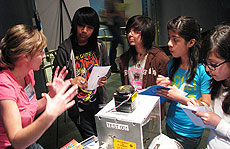Museum’s Spring into Science career expo a "huge success"
 |
|
Fermilab’s Linda Purcell-Taylor explains what she does in her job to a group of girls from Sawyer Elementary School in Chicago. Credit: Christine Herman
|
In a large, open space in the northwest wing of Chicago’s Museum of Science and Industry, scientists and engineers staffed tables that lined the room. With their science demos in place and smiles on their faces, they welcomed more than 1,000 people to the museum’s Spring into Science career expo on Saturday, May 21.
“The event was a huge success,” said Lizza Igoe, education coordinator at the museum and event organizer, in an email to the volunteers. “[Everyone] thoroughly enjoyed learning about different career opportunities in the fields of science, technology, engineering and medicine, as well as getting a glimpse into the working world.”
Fermilab’s Mike Albrow, a particle physicist, and Linda Purcell-Taylor, a senior technician, volunteered at the event.
Purcell-Taylor placed a secondary emission monitor, also known as a beam profile monitor, on the Fermilab table.
The round, metallic device has a 4-inch diameter hole through the middle, which allows the particle beam to pass through. At the push of a button, a wire mesh material moves into the pathway of the particle beam. As particles pass through the mesh, they interact with the wires and create electrical signals that are collected and processed by a computer.
“This is part of a system we use to see the shape of the beam and where it is going through the beamline so that we can adjust magnets to steer it,” Purcell-Taylor explained to a group of girls from Sawyer Elementary School in Chicago, who crowded around the table to take a look.
One of the girls, Giselle Castañeda, a sixth grader, said she is part of the science club at her school and wants to be a teacher when she grows up. Castañeda and her friends jotted down notes as Purcell-Taylor talked about her job.
“I like that every day I’m learning something new about science,” Purcell-Taylor said to the girls.
Albrow also captured the students’ attention with a real-time cosmic ray detector. The device, which is about the size of a narrow shoe box and is filled with plastic particle-detecting fibers, was connected to a camera that transmitted the image to his laptop.
Read more
— Christine Herman
|